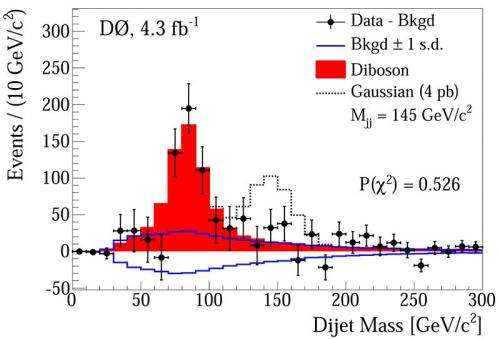June 13, 2011 report
Fermilab experiment fails to confirm new particle claim

(PhysOrg.com) -- In April, scientists at one of Fermilab’s two particle detectors, CDF, observed what they thought might be a new particle not predicted by the Standard Model. But now, scientists at the lab’s second detector, DZero, have cross-checked the observation with their own independent data and analysis tools, and have found no evidence of a new particle. Instead, the DZero data are in agreement with predictions from the Standard Model.
Originally, CDF scientists observed the possible new particle when analyzing proton-antiproton collisions that produce a W boson - a particle associated with the weak nuclear force - and two jets of particles. At a collision energy of about 145 GeV, the scientists observed about 253 more electrons and muons than expected. The excess implies the existence of a particle with a mass of 145 GeV, but no known particles have this mass. The finding led the scientists to predict the existence of a new particle with a mass of 145 GeV that decays into an extra W boson that in turn decays into electrons and muons, in addition to other decay products. Some theorists suggested that the new particle might provide evidence for a fifth fundamental force of nature known as "technicolor.”
At first, the effect at CDF had a magnitude of three standard deviations, or “three sigma,” which means that there is about a 1 in 1,000 chance that the result is attributable to some statistical fluctuation in the data. In particle physics, the three-sigma level of certainty is intriguing, but a five-sigma level (about a 1 in 1 million chance that the result is a fluke) is needed to claim a discovery. Then, at a conference on May 30th at Blois, France, CDF co-spokesperson Giovanni Punzi announced that the scientists had analyzed more data and the effect was now at just below the five-sigma level.
So DZero’s failure to confirm the same excess at 145 GeV is a bit of a letdown. On the other hand, it raises the question of what exactly is causing the discrepancy between the two results. Fermilab has two detectors for this very reason, to check each other’s results. However, disagreements like this one don’t occur very often. For the more than 500 measurements that CDF and DZero have independently detected and analyzed over the past 10 years, the results have agreed more than 99% of the time.
“This is exactly how science works,” said DZero co-spokesperson Stefan Sӧldner-Rembold in a Fermilab press release. “Independent verification of any new observation is the key principle of scientific research. At the Tevatron, we have two experiments that, by design, can check each other.”
Going forward, Fermilab plans to create a task force that will consist of scientists from both CDF and DZero to coordinate an analysis of the two detectors’ results in order to understand the disagreement.
The investigation for the possible 145-GeV particle could be one of the last opportunities to discover new physics at Fermilab’s Tevatron, at least while it’s still running. The collidor is scheduled to be shut down this September due to budget cuts at the US Department of Energy. After the final shutdown, scientists will still have billions of collision events to sift through, and they expect that data analysis will continue for at least five more years.
More information: DZero paper (submitted to Physical Review Letters) and CDF paper (published in Physical Review Letters)
via: Fermilab press release, BBC News, Wired
© 2010 PhysOrg.com


















